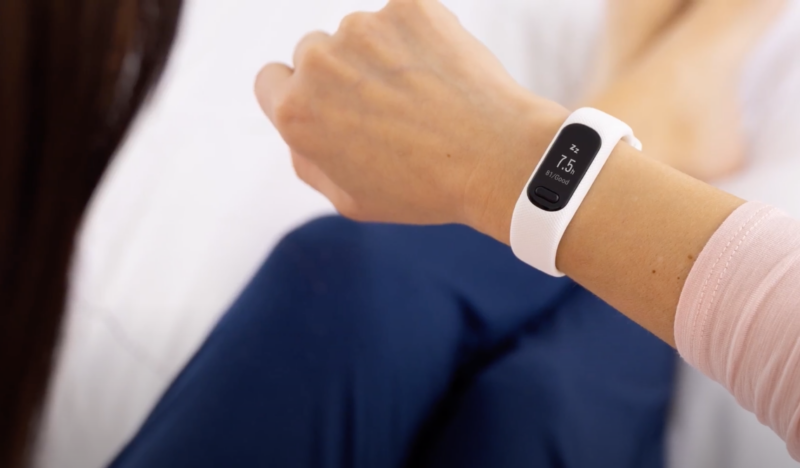

Garmin’s new Vívosmart 5 meets stiff competition with an empty bag of tricks
source link: https://arstechnica.com/gadgets/2022/04/garmin-launches-vivosmart-5-fitness-tracker-4-years-after-predecessor-with-little-new/
Go to the source link to view the article. You can view the picture content, updated content and better typesetting reading experience. If the link is broken, please click the button below to view the snapshot at that time.

Old dog, old tricks —
Garmin’s new Vívosmart 5 meets stiff competition with an empty bag of tricks
The new basic fitness tracker hasn't progressed much, while Fitbits have.
Corey Gaskin - 4/20/2022, 12:38 PM

Garmin has just released its latest fitness tracker, the Vívosmart 5, a wearable made to cover the basics of sleep and activity tracking and deliver phone notifications. It replaces the now 4-year-old Vívosmart 4. But in four years’ time, the new tracker hasn’t evolved much from the last version, while competition like Fitbit’s Charge 5 has made significant leaps.
When Garmin released the Vívosmart 4 in 2018, it had advantages like a then-rare blood oxygen sensor and Garmin’s typical suite of in-depth health metrics that surpassed most competitors. Now, Fitbit’s equally priced Charge 5 fitness tracker has blood oxygen sensors, too, as well as electrodermal sensors (for stress measuring), GPS, and the ability to take ECG readings—all things the new Vívosmart 5 lacks.
I spent a weekend sleeping, working out, and tracking my body’s vitals with the Vívosmart 5 before its official launch to get a quick look at the device and get an idea of whether Garmin’s in-depth data and proprietary metrics could still make this a worthwhile buy. As it is a pre-release model, there were some known bugs but nothing that would prevent us from getting a clear picture of its capabilities.
Slight physical changes
-
Garmin's Vívosmart 5 looks a lot like the Vívosmart 4, and that's because it is—in form and function.
-
It's a narrow silicone wearable, about the width of a watch strap. Underneath is a traditional watch strap buckle. Watch straps are now interchangeable, as well.
The Vívosmart 5 has the same basic appearance as the 4. It’s a slim silicone fitness band with a small black-and-white OLED screen. The band buckles together like a traditional watch strap, just as its predecessor did, except now the bands are interchangeable by simply popping the tracker out. It looks seamless, and you must take it off your wrist to get the tracker out.
The screen has grown by 66 percent, but that hasn’t made it any bulkier. Even with a wider screen, it’s still a narrow device. Garmin also integrated a physical home/back button below the screen, where a haptic one used to sit. The plastic button takes deliberate pressure to depress, so I never had errant button pushes in my time with the device.
Advertisement
Animations on the screen are smooth, and the touch response is good. It is a small screen, though, measuring about an inch long and a half-inch wide. So, while menu widgets and text fit fine, longer notifications, like emails or texts, require some scrolling. The screen can fit at most eight short words at a time.
Activity tracking
The Vívosmart 5 can track heart rate, blood oxygen levels, stress, and respiration rates throughout the day and night. There are 14 modes for activity tracking, including HIIT, yoga, strength training, and breathwork, among others. Garmin also enables menstruation cycle tracking within the companion app.
Both activity and sleep tracking data trended close to readings picked up on my Apple Watch Series 7 and Google Nest hub’s sleep detection. The Vívosmart’s heart rate data and related calorie burns were on track with the Apple Watch’s activity readings, but the deeper analytics for which one might typically choose a Garmin device aren’t there.
Since it’s a more basic tracker, calories, heart rate, and heart rate zones are the only data you’ll gather from activities. There’s no built-in GPS, so you’ll have to carry your phone with you if you’d like location data logged on a run or cycle. And you won’t find analyses of your anaerobic and aerobic gains as you would with more robust Garmin wearables, like the Forerunner lineup, for instance.
-
The Vívosmart only offers basic activity stats like heart rate and calories burned.
-
Charts let you see your heart rate zones and data after a workout.
-
The Vívosmart's metrics are close to the Apple Watch Series 7's results, and offer the same amount of data. Most of Garmin's in-depth analytics and metrics haven't made their way to the Vívosmart 5.
The Vívosmart does have Garmin’s Body Battery metric, which helps you gauge your daily recovery and exertion, but it’s not as robust or prescriptive as Fitbit’s Daily Readiness feature. As opposed to simply portraying a zero to 100 percent score like Garmin, Fitbit also recommends specific workouts for your days, depending on if it thinks you need to focus on intense, moderate, or recovery-centered activity.
Fitbit charges $10 a month for this, along with other data and content, within its Fitbit Premium subscription plan, though—a subscription model Garmin has said it won’t replicate, as an increasing number of wearable manufacturers have also said.
Recommend
About Joyk
Aggregate valuable and interesting links.
Joyk means Joy of geeK
